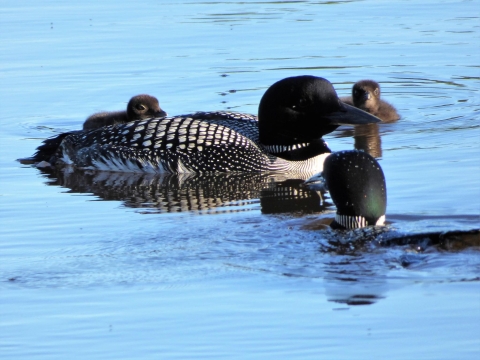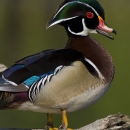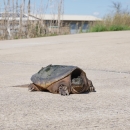Seasons of Wildlife
Spring
Spring is a busy time at the refuge. Wildlife, dormant for the winter, begins to wake. Black bears rouse and their cubs, which were born over the winter, venture out of the den for the first time. The lively, little chipmunks began their never-ending search for food. Virtually frogcicles during the winter, wood frogs and spring peepers thaw and begin their mating songs. Old friends, like Canada geese, common loons and trumpeter swans return from their wintering grounds to raise their families, filling the air with their calls. Visitors at this time may be lucky enough to see the mating dance of the sandhill cranes or sharp-tailed grouse. Late May is a great time for birders to enjoy spotting warblers and listen for the calls of rails.
Summer
Beware of the biting insects (black flies, deer flies, mosquitoes, etc.) and ticks which emerge this time of year. Despite the insects, spring and summer are the best times to view many species of wildlife and their young. Imagine early June when snapping turtles nest along the roadsides. If you are brave enough to endure the bugs, you can take a trip to the bogs and search for rare orchids in bloom. Or, watch the drama on the refuge pools from the comfort of your vehicle on the wildlife drive. See ospreys fishing in the ponds, waterfowl defending their territory, otters playing or beavers busy building dams. The scene at the refuge changes by the minute; you never know what excitement lies around the next bend.
Fall
As the weather begins to turn colder, animals begin their preparations for winter. Migratory birds begin their long journey to their wintering grounds, fat from the bounty the northland has to offer. The birds aren't the only animals preparing for a long journey. The last generations of monarch butterflies have a long voyage ahead. These amazing insects fly from points as far north as Canada, all the way to Mexico where they will winter before starting their journey north again. Although that generation will never see its place of birth again, their descendants somehow find their way back to their ancestral home. The fall colors at Seney are breathtaking whether viewed by car, bike, foot, canoe or kayak.
Winter
Don’t let the cold weather and snow cover fool you. There is still a lot of action on the refuge. While the animals are harder to see, signs they were here can be found everywhere. Coyote and wolves leave tracks, otters run and slide across the snow, mice, like little miners, build elaborate tunnels under the snow and squirrels can be seen scrounging for scraps on the forest floor. Although the visitor center is closed, the cross-country ski trails are open and normally groomed once a week. Snowshoeing is popular as well, but please refrain from walking on the cross-country ski trails.
Featured Species
What plants and animals you see during your visit?
The refuge's diversity of habitats provides homes for a wide array of life. As you explore look and listen. Many animals may be difficult to spot, but by watching for movement and signs, listening for sounds, driving or walking slowly and stopping frequently you can increase your viewing opportunities. The refuge provides habitat for a wide variety of life in multiple habitats. More than 200 species of birds, 26 species of fish, 50 species of mammals, 22 species of reptiles and amphibians and more than 420 plant species have been recorded on the refuge. What will you see when you visit?
Birds
The refuge is known for its abundance of trumpeter swans, common loons, bald eagles, osprey and sandhill cranes, which are commonly seen while driving the Marshland Wildlife Drive or walking the Pine Ridge Nature Trail. Other familiar favorites include American bitterns, rails and numerous warbler species.
The Whitefish Point Unit is located 80 miles away from the main body of the refuge. This 53-acre tract is known for its concentration of birds during migration. Each year thousands of raptors, perching birds and waterbirds funnel through the point stopping to replenish their energy reserves before or after crossing Lake Superior. Since its inception, the Whitefish Point Bird Observatory has documented and studied more than 300 species of birds using the point. The data collected by the observatory has led to the area being recognized as a Globally Important Bird Area for birds migrating between the U.S. and Canada.
Mammals
Do you enjoy watching the antics of chipmunks searching for food? Do you sympathize with the red squirrels scolding you for invading its territory? Do you enjoy the challenge of identifying a beaver from a muskrat or otter swimming in one of the refuge's pools? What about the challenge of looking for white-tailed deer, fisher, mink, black bear, coyote or wolves? You will increase your chances of seeing mammals by visiting the refuge near dawn and dusk. Vehicles make good blinds but if you open your door and get out the animal may flee.
Reptiles and Amphibians
Listen... Frogs and toads can be noisy. Spring peepers call from dusk to dawn. Mink and green frogs can be heard throughout the day. Look... Turtles can be seen nesting on the roadside in the spring or sunning themselves on downed trees, banks or rocks. Snakes may be seen throughout the refuge while salamanders need moist environments. Knowing when and where to look is helpful.
Insects, Spiders and Other Invertebrates
The refuge is home to thousands of species of invertebrates or animals without spines. These animals are often overlooked, but come in a wide variety of sizes, shapes and colors depending on their habitat and what they eat. Some species, like butterflies and dragonflies, are easily noticed and appreciated. Others are well camouflaged, hiding in plain site. So slow down and take a closer look at that plant. You may notice ants farming a colony of aphids, milking them for their sweet honeydew; a well camouflaged crab spider patiently waiting for an insect to visit a flower; or a bumblebee crawling into a turtlehead flower to collect its nectar. How many species of pollinators can you find on one plant?
Plants
Hundreds of plants have been documented living on the refuge. Depending on the time of your visit you will notice different plants in bloom and different types of mushrooms dotting the landscape. In spring, visitors may notice the delicate woodland wildflowers dotting the forest floors like Dutchman's breeches, trout lily, starflower, blueberries, trilliums, spring beauty, lady's slippers and the fragrant trailing arbutus. You may notice wetlands dotted with marsh marigold, sundew, Labrador tea and swam laurel. In summer spreading dogbane, milkweeds, purple pitcher plants, fireweed and wood lilies bloom. Forages can find blueberries, huckleberries, raspberries, thimbleberries and other edible plants. Fall wildflowers like goldenrods and asters provide pops of color on the forest floor while maple, birch and aspen leaves change color providing quite the show. Tamarack's needles turn bright gold and drop. In winter, pine trees dot the landscape in green against the white of the snow.
Fungi
Fungi are great for beginning photographers and they are very interesting. They come in a wide variety of sizes, shapes and all the colors of the rainbow. Some even glow in the dark! They are usually more robust and do not blow in the wind like plants so focusing your camera is much easier. Depending on the time of your visit different types of mushrooms may be fruiting. Foragers are welcome on the refuge, see the rules and regulations section for harvest limits. Some mushrooms are poisonous, so only experts should eat their findings. In spring, seasonal mushroom begin to pop out. Look for morels, false morels, scarlet elfcups, spring orange peel and witch's butter. In summer, look for chicken of the woods, violet coral fungus, white saddles, black trumpets, chicken lips and coral tooth fungi. Have fun with fungi in the fall. Look for purple jellydiscs, crystal brain fungus, stinkhorns, golden spindles, yellow fairy cups, puffballs, fairy fans, parrot, eyelash cups and dead man's fingers. In the fall fungi abound. Turkey-tails, splitgills, polypores, hemlock varnish shelfs, oyster mushrooms and a while host of lichens, which are part fungus part algae, can be found throughout the year, even in the winter.








